Drug Catalog - Product Detail
LEVOFLOXACIN TABLETS TB 250MG 50
| NDC | Mfr | Size | Str | Form |
|---|---|---|---|---|
| 68180-0240-08 | LUPIN PHARMACEUTICALS | 50 | 250MG | TABLET |
PACKAGE FILES
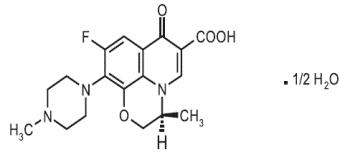
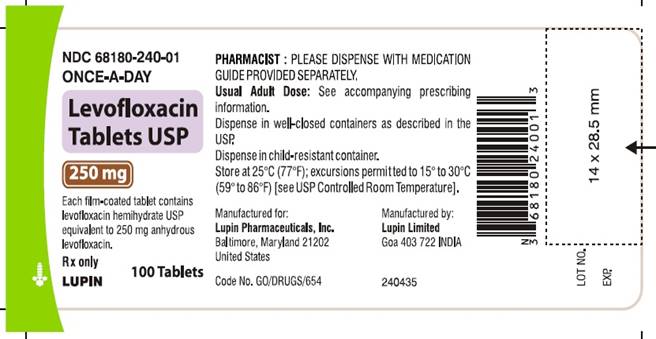
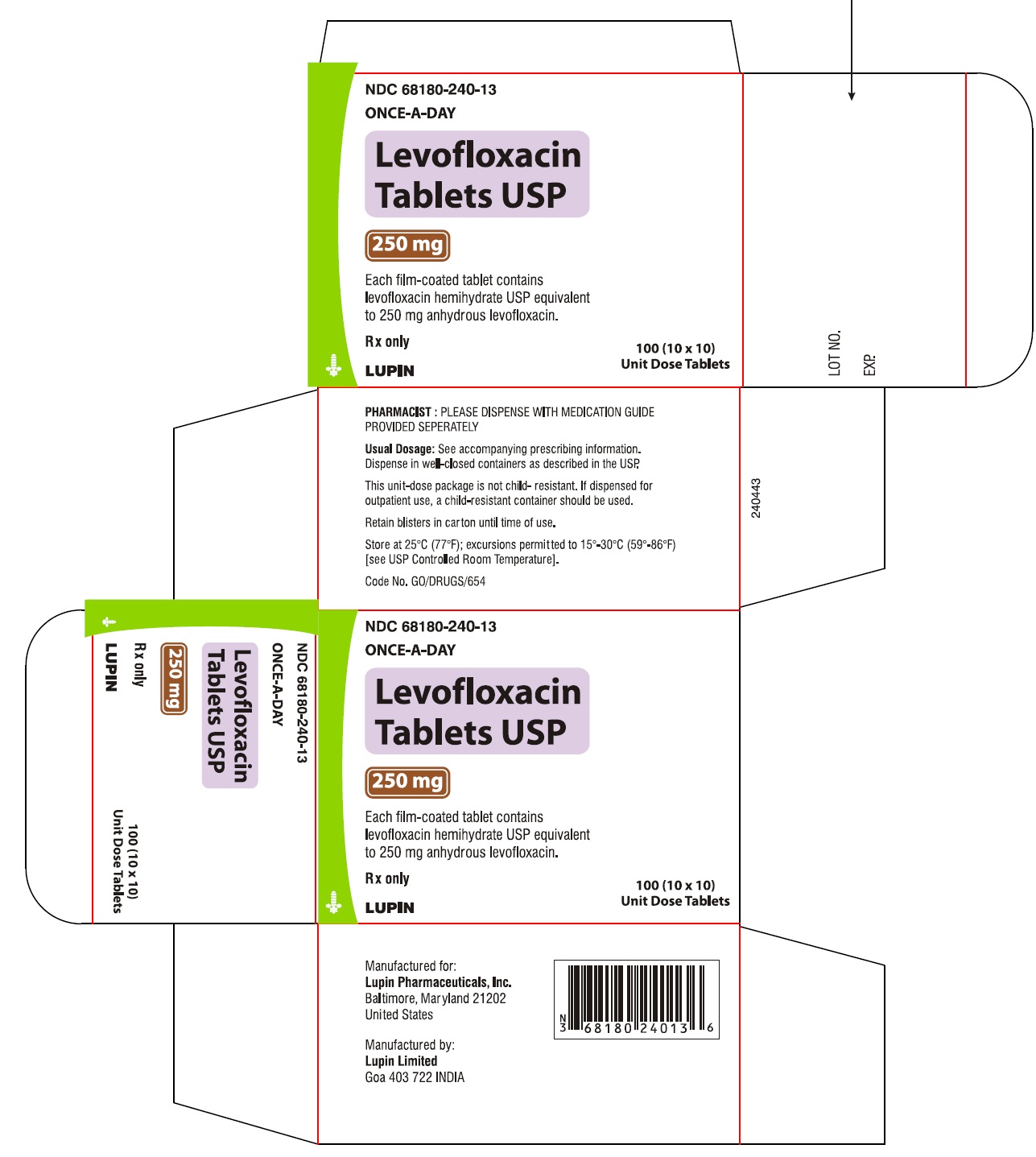
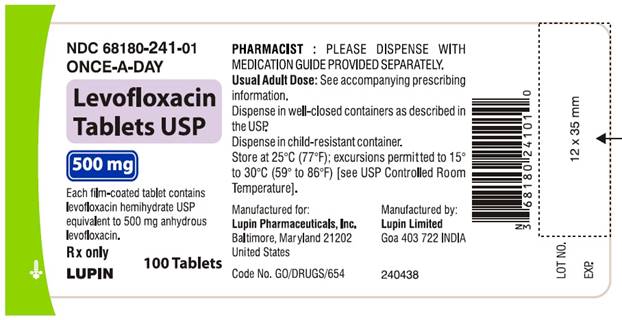
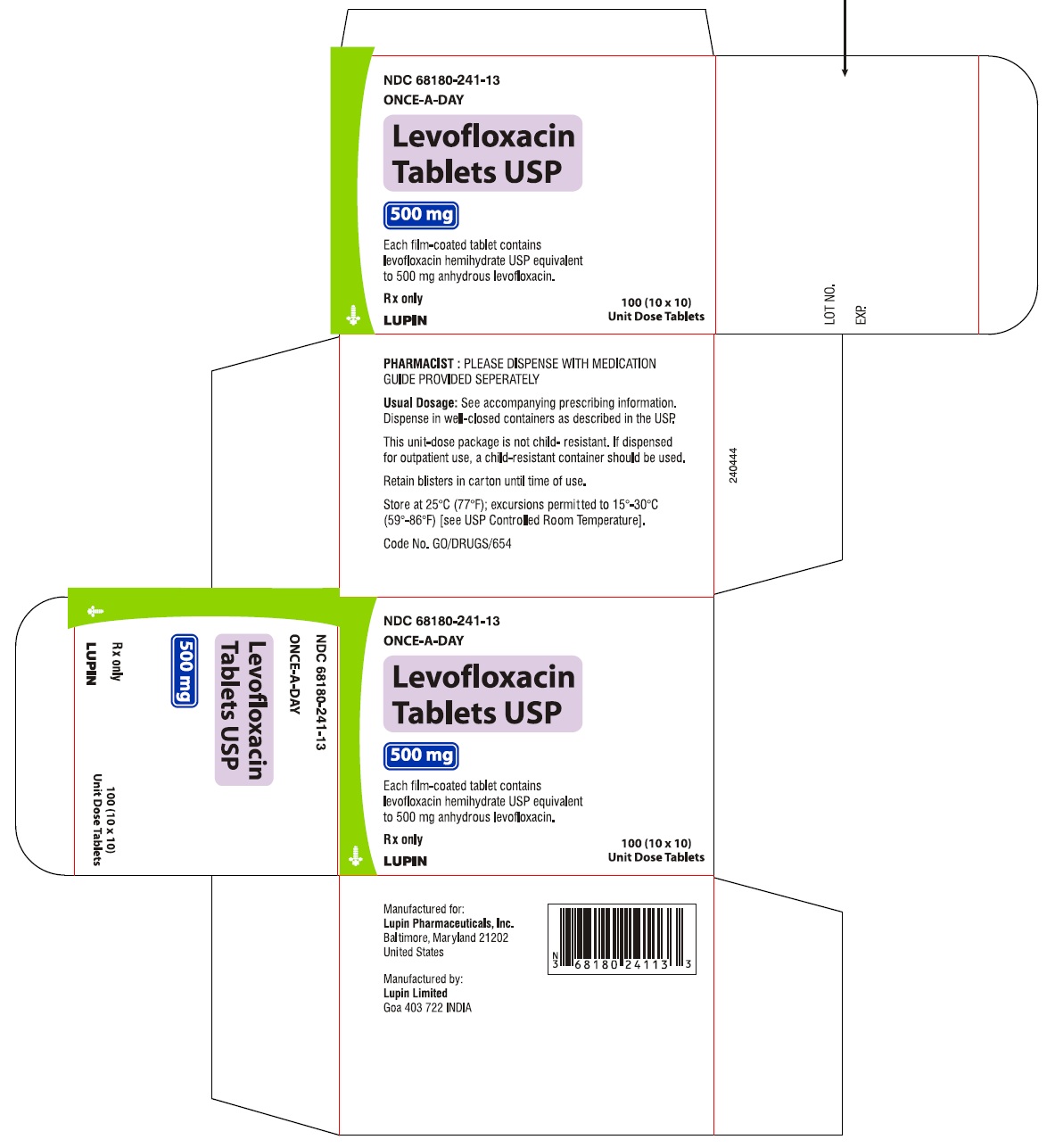
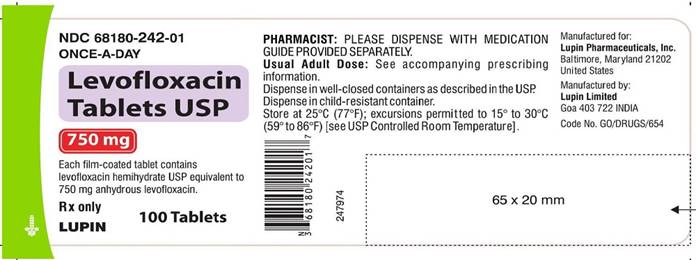
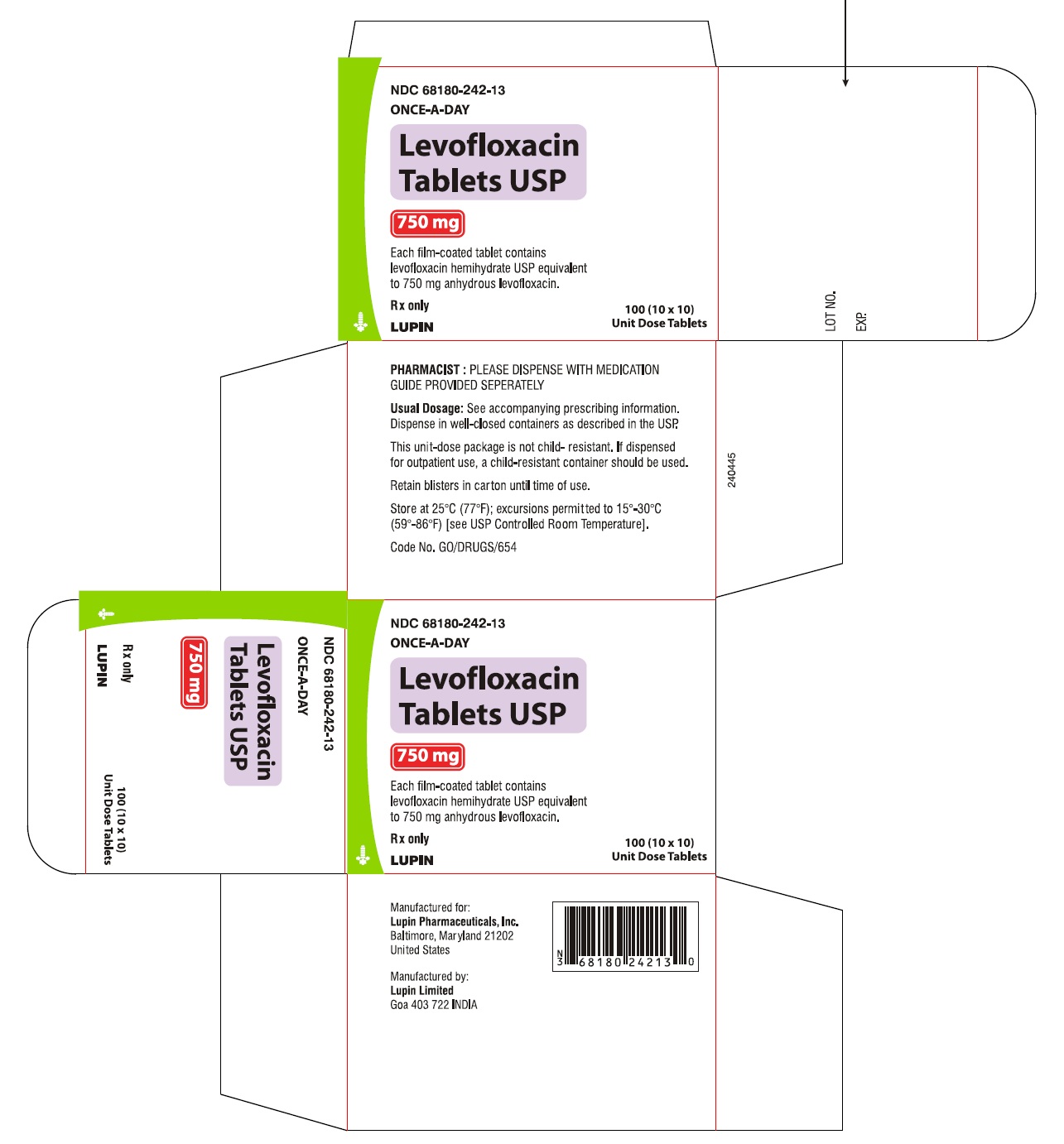
Generic Name
LEVOFLOXACIN
Substance Name
LEVOFLOXACIN
Product Type
HUMAN PRESCRIPTION DRUG
Route
ORAL
Application Number
ANDA078424
Description
11 DESCRIPTION Levofloxacin tablets are synthetic antibacterial agents for oral administration. Chemically, levofloxacin, a chiral fluorinated carboxyquinolone, is the pure (-)-(S)-enantiomer of the racemic drug substance ofloxacin. The chemical name is (-)-(S)-9-fluoro-2,3-dihydro-3-methyl-10-(4-methyl-1-piperazinyl)-7-oxo-7H-pyrido[1,2,3-de]-1,4-benzoxazine-6-carboxylic acid hemihydrate. Figure 1: The Chemical Structure of Levofloxacin The empirical formula is C 18 H 20 FN 3 O 4 • ½ H 2 O and the molecular weight is 370.38. Levofloxacin is a light yellowish-white to yellow-white crystal or crystalline powder. The molecule exists as a zwitterion at the pH conditions in the small intestine. The data demonstrate that from pH 0.6 to 5.8, the solubility of levofloxacin is essentially constant (approximately 100 mg/mL). Levofloxacin is considered soluble to freely soluble in this pH range, as defined by USP nomenclature. Above pH 5.8, the solubility increases rapidly to its maximum at pH 6.7 (272 mg/mL) and is considered freely soluble in this range. Above pH 6.7, the solubility decreases and reaches a minimum value (about 50 mg/mL) at a pH of approximately 6.9. Levofloxacin has the potential to form stable coordination compounds with many metal ions. This in vitro chelation potential has the following formation order: Al +3 >Cu +2 >Zn +2 >Mg +2 >Ca +2 . Levofloxacin tablets USP are available as film-coated tablets and contain the following inactive ingredients: 250 mg (as expressed in the anhydrous form): crospovidone, hypromellose, iron oxide black, iron oxide red, magnesium stearate, microcrystalline cellulose, polyethylene glycol, polysorbate 80, propylene glycol, shellac and titanium dioxide. 500 mg (as expressed in the anhydrous form): crospovidone, hypromellose, iron oxide black, iron oxide red, iron oxide yellow, magnesium stearate, microcrystalline cellulose, polyethylene glycol, polysorbate 80, propylene glycol, shellac and titanium dioxide. 750 mg (as expressed in the anhydrous form): crospovidone, hypromellose, iron oxide black, magnesium stearate, microcrystalline cellulose, polyethylene glycol, polysorbate 80, propylene glycol, shellac and titanium dioxide. Levofloxacin tablets USP meets USP Dissolution Test 2. Image
How Supplied
16 HOW SUPPLIED/STORAGE AND HANDLING Levofloxacin tablets USP are supplied as 250, 500, and 750 mg coated tablets. Levofloxacin tablets USP are packaged in bottles and in unit-dose blister strips in the following configurations: 250 mg tablets are terra cotta pink, oblong shaped, film-coated tablets, imprinted 'L021' (in black ink) on one side and plain on the other side. Bottles of 50 NDC 68180-240-08 Bottles of 100 NDC 68180-240-01 Bottles of 500 NDC 68180-240-02 Unit Dose Blisters of 10x10s NDC 68180-240-13 500 mg tablets are peach, oblong shaped, film-coated tablets, imprinted 'L022' (in black ink) on one side and plain on the other side. Bottles of 50 NDC 68180-241-08 Bottles of 100 NDC 68180-241-01 Bottles of 500 NDC 68180-241-02 Unit Dose Blisters of 10x10s NDC 68180-241-13 750 mg tablets are white, capsule-shaped, film-coated tablets, imprinted 'L023' (in black ink) on one side and plain on the other side. Bottles of 20 NDC 68180-242-20 Bottles of 100 NDC 68180-242-01 Bottles of 500 NDC 68180-242-02 Unit Dose Blisters of 10x10s NDC 68180-242-13 Stored at 25°C (77°F); excursions permitted to 15° to 30°C (59° to 86°F) [see USP Controlled Room Temperature] in well-closed containers as described in the USP.
Indications & Usage
1 INDICATIONS AND USAGE Levofloxacin is a fluoroquinolone antibacterial indicated in adults (18 years of age and older) with infections caused by designated, susceptible bacteria and in pediatric patients where indicated ( 1 , 12.4 ). Pneumonia: Nosocomial ( 1.1 ) and Community Acquired ( 1.2 , 1.3 ) Skin and Skin Structure Infections (SSSI): Complicated ( 1.4 ) and Uncomplicated ( 1.5 ) Chronic bacterial prostatitis ( 1.6 ) Inhalational Anthrax, Post-Exposure in adult and pediatric patients ( 1.7 ) Plague in adult and pediatric patients ( 1.8 ) Urinary Tract Infections (UTI): Complicated (1.9, 1.10) and Uncomplicated ( 1.12 ) Acute Pyelonephritis ( 1.11 ) Acute Bacterial Exacerbation of Chronic Bronchitis ( 1.13 ) Acute Bacterial Sinusitis ( 1.14 ) Usage To reduce the development of drug-resistant bacteria and maintain the effectiveness of levofloxacin and other antibacterial drugs, levofloxacin tablets should be used only to treat or prevent infections that are proven or strongly suspected to be caused by bacteria ( 1.15 ). 1.1 Nosocomial Pneumonia Levofloxacin tablets USP are indicated in adult patients for the treatment of nosocomial pneumonia due to methicillin-susceptible Staphylococcus aureus, Pseudomonas aeruginosa, Serratia marcescens, Escherichia coli, Klebsiella pneumoniae, Haemophilus influenzae, or Streptococcus pneumoniae. Adjunctive therapy should be used as clinically indicated. Where Pseudomonas aeruginosa is a documented or presumptive pathogen, combination therapy with an anti-pseudomonal β-lactam is recommended [see Clinical Studies ( 14.1 )] . 1.2 Community-Acquired Pneumonia: 7 to 14 day Treatment Regimen Levofloxacin tablets USP are indicated in adult patients for the treatment of community-acquired pneumonia due to methicillin-susceptible Staphylococcus aureus, Streptococcus pneumoniae (including multi-drug-resistant Streptococcus pneumoniae [MDRSP]), Haemophilus influenzae, Haemophilus parainfluenzae, Klebsiella pneumoniae, Moraxella catarrhalis, Chlamydophila pneumoniae, Legionella pneumophila, or Mycoplasma pneumoniae [see Dosage and Administration ( 2.1 ) and Clinical Studies ( 14.2 )] . MDRSP isolates are isolates resistant to two or more of the following antibacterials: penicillin (MIC ≥2 mcg/mL), 2 nd generation cephalosporins, e.g., cefuroxime, macrolides, tetracyclines and trimethoprim/sulfamethoxazole. 1.3 Community-Acquired Pneumonia: 5-day Treatment Regimen Levofloxacin tablets USP are indicated in adult patients for the treatment of community-acquired pneumonia due to Streptococcus pneumoniae (excluding multi-drug-resistant isolates [MDRSP]), Haemophilus influenzae, Haemophilus parainfluenzae, Mycoplasma pneumoniae, or Chlamydophila pneumoniae [see Dosage and Administration ( 2.1 ) and Clinical Studies ( 14.3 )] . 1.4 Complicated Skin and Skin Structure Infections Levofloxacin tablets USP are indicated in adult patients for the treatment of complicated skin and skin structure infections due to methicillin-susceptible Staphylococcus aureus, Enterococcus faecalis, Streptococcus pyogenes, or Proteus mirabilis [see Clinical Studies ( 14.5 )] . 1.5 Uncomplicated Skin and Skin Structure Infections Levofloxacin tablets USP are indicated in adult patients for the treatment of uncomplicated skin and skin structure infections (mild to moderate) including abscesses, cellulitis, furuncles, impetigo, pyoderma, wound infections, due to methicillin-susceptible Staphylococcus aureus, or Streptococcus pyogenes. 1.6 Dosage of Levofloxacin Tablets Levofloxacin tablets USP are indicated in adult patients for the treatment of chronic bacterial prostatitis due to Escherichia coli, Enterococcus faecalis, or methicillin-susceptible Staphylococcus epidermidis [see Clinical Studies ( 14.6 )] . 1.7 Inhalational Anthrax (Post-Exposure) Levofloxacin tablets USP are indicated for inhalational anthrax (post-exposure) to reduce the incidence or progression of disease following exposure to aerosolized Bacillus anthracis in adults and pediatric patients, 6 months of age and older [see Dosage and Administration ( 2.2 )]. The effectiveness of levofloxacin is based on plasma concentrations achieved in humans, a surrogate endpoint reasonably likely to predict clinical benefit. Levofloxacin has not been tested in humans for the post-exposure prevention of inhalation anthrax. The safety of levofloxacin in adults for durations of therapy beyond 28 days or in pediatric patients for durations of therapy beyond 14 days has not been studied. Prolonged levofloxacin therapy should only be used when the benefit outweighs the risk [see Clinical Studies ( 14.9 )] . 1.8 Plague Levofloxacin tablets USP are indicated for treatment of plague, including pneumonic and septicemic plague, due to Yersinia pestis ( Y. pestis ) and prophylaxis for plague in adults and pediatric patients, 6 months of age and older [ see Dosage and Administration ( 2.2 )]. Efficacy studies of levofloxacin could not be conducted in humans with plague for ethical and feasibility reasons. Therefore, approval of this indication was based on an efficacy study conducted in animals [see Clinical Studies ( 14.10 )] . 1.9 Complicated Urinary Tract Infections: 5-day Treatment Regimen Levofloxacin tablets USP are indicated in adult patients for the treatment of complicated urinary tract infections due to Escherichia coli, Klebsiella pneumoniae, or Proteus mirabilis [see Clinical Studies ( 14.7 )] . 1.10 Complicated Urinary Tract Infections: 10-day Treatment Regimen Levofloxacin tablets USP are indicated in adult patients for the treatment of complicated urinary tract infections (mild to moderate) due to Enterococcus faecalis, Enterobacter cloacae, Escherichia coli, Klebsiella pneumoniae, Proteus mirabilis, or Pseudomonas aeruginosa [see Clinical Studies ( 14.8 )] . 1.11 Acute Pyelonephritis: 5 or 10-day Treatment Regimen Levofloxacin tablets USP are indicated in adult patients for the treatment of acute pyelonephritis caused by Escherichia coli, including cases with concurrent bacteremia [see Clinical Studies ( 14.7 , 14.8 )] . 1.12 Uncomplicated Urinary Tract Infections Levofloxacin tablets USP are indicated in adult patients for the treatment of uncomplicated urinary tract infections (mild to moderate) due to Escherichia coli, Klebsiella pneumoniae, or Staphylococcus saprophyticus. Because fluoroquinolones, including levofloxacin, have been associated with serious adverse reactions [see Warnings and Precautions ( 5.1 to 5.15 )] and for some patients uncomplicated urinary tract infection is self-limiting, reserve levofloxacin for treatment of uncomplicated urinary tract infections in patients who have no alternative treatment options. 1.13 Acute Bacterial Exacerbation of Chronic Bronchitis Levofloxacin tablets USP are indicated in adult patients for the treatment of acute bacterial exacerbation of chronic bronchitis (ABECB) due to methicillin-susceptible Staphylococcus aureus, Streptococcus pneumoniae, Haemophilus influenzae, Haemophilus parainfluenzae, or Moraxella catarrhalis. Because fluoroquinolones, including levofloxacin, have been associated with serious adverse reactions [see Warnings and Precautions ( 5.1 to 5.15 )] and for some patients ABECB is self-limiting, reserve levofloxacin for treatment of ABECB in patients who have no alternative treatment options. 1.14 Acute Bacterial Sinusitis: 5-day and 10 to 14 day Treatment Regimens Levofloxacin tablets USP are indicated in adult patients for the treatment of acute bacterial sinusitis (ABS) due to Streptococcus pneumoniae, Haemophilus influenzae, or Moraxella catarrhalis [see Clinical Studies ( 14.4 )] . Because fluoroquinolones, including levofloxacin, have been associated with serious adverse reactions [see Warnings and Precautions ( 5.1 to 5.15 )] and for some patients ABS is self-limiting, reserve levofloxacin for treatment of ABS in patients who have no alternative treatment options. 1.15 Usage To reduce the development of drug-resistant bacteria and maintain the effectiveness of levofloxacin tablets USP and other antibacterial drugs, levofloxacin tablets USP should be used only to treat or prevent infections that are proven or strongly suspected to be caused by susceptible bacteria. When culture and susceptibility information are available, they should be considered in selecting or modifying antibacterial therapy. In the absence of such data, local epidemiology and susceptibility patterns may contribute to the empiric selection of therapy. Culture and susceptibility testing Appropriate culture and susceptibility tests should be performed before treatment in order to isolate and identify organisms causing the infection and to determine their susceptibility to levofloxacin [see Microbiology ( 12.4 )] . Therapy with levofloxacin may be initiated before results of these tests are known; once results become available, appropriate therapy should be selected. As with other drugs in this class, some isolates of Pseudomonas aeruginosa may develop resistance fairly rapidly during treatment with levofloxacin. Culture and susceptibility testing performed periodically during therapy will provide information about the continued susceptibility of the pathogens to the antimicrobial agent and also the possible emergence of bacterial resistance.
Dosage and Administration
2 DOSAGE AND ADMINISTRATION Administer levofloxacin tablets to pediatric patients weighing 30 kg and greater only ( 2.1 , 2.2 ). Levofloxacin tablets cannot be administered to pediatric patients who weigh less than 30 kg because of the limitations of the available strengths. Alternative formulations of levofloxacin may be considered for pediatric patients who weigh less than 30 kg ( 2.2 ). Dosage in Adult and Pediatric Patients with Creatinine Clearance greater than or equal to 50 mL/minute ( 2.1 . 2.2 ) Type of Infection Dose Every 24 hours Duration (days) Nosocomial Pneumonia ( 1.1 ) 750 mg 7 to 14 Community Acquired Pneumonia ( 1.2 ) 500 mg 7 to 14 Community Acquired Pneumonia ( 1.3 ) 750 mg 5 Complicated SSSI ( 1.4 ) 750 mg 7 to 14 Uncomplicated SSSI ( 1.5 ) 500 mg 7 to 10 Chronic Bacterial Prostatitis ( 1.6 ) 500 mg 28 Inhalational Anthrax (Post-Exposure) ( 1.7 ) Adults and Pediatric Patients 50 kg or greater Pediatric Patients 30 kg to less than 50 kg ( 2.2 ) 500 mg 250 mg every 12 hours 60 60 Plague ( 1.8 ) Adults and Pediatric Patients 50 kg or greater Pediatric Patients 30 kg to less than 50 kg ( 2.2 ) 500 mg 250 mg every 12 hours 10 to 14 10 to 14 Complicated UTI ( 1.9 ) or Acute Pyelonephritis ( 1.11 ) 750 mg 5 Complicated UTI ( 1.10 ) or Acute Pyelonephritis ( 1.11 ) 250 mg 10 Uncomplicated UTI ( 1.12 ) 250 mg 3 Acute Bacterial Exacerbation of Chronic Bronchitis ( 1.13 ) 500 mg 7 Acute Bacterial Sinusitis ( 1.14 ) 750 mg 5 500 mg 10 to 14 Adjust dose for creatinine clearance less than 50 mL/minute ( 2.3 , 8.6 , 12.3 ) 2.1 Dosage of Levofloxacin Tablets in Adult Patients with Creatinine Clearance ≥ 50 mL/minute The usual dose of levofloxacin tablets is 250 mg, 500 mg, or 750 mg administered orally every 24 hours, as indicated by infection and described in Table 1. These recommendations apply to patients with creatinine clearance ≥ 50 mL/minute. For patients with creatinine clearance less than 50 mL/min, adjustments to the dosing regimen are required [see Dosage and Administration ( 2.3 )] . Table 1: Dosage of Levofloxacin Tablets in Adult Patients with Creatinine Clearance greater than or equal to 50 mL/minute * Due to the designated pathogens [see Indications and Usage ( 1 )] . † Sequential therapy (intravenous levofloxacin to oral levofloxacin tablets) may be instituted at the discretion of the healthcare provider. ‡ Due to methicillin-susceptible Staphylococcus aureus, Streptococcus pneumoniae (including multi-drug-resistant isolates [MDRSP]), Haemophilus influenzae, Haemophilus parainfluenzae, Klebsiella pneumoniae, Moraxella catarrhalis, Chlamydophila pneumoniae, Legionella pneumophila, or Mycoplasma pneumoniae [see Indications and Usage ( 1.2 )] . § Due to Streptococcus pneumoniae (excluding multi-drug-resistant isolates [MDRSP]), Haemophilus influenzae, Haemophilus parainfluenzae, Mycoplasma pneumoniae, or Chlamydophila pneumoniae [see Indications and Usage ( 1.3 )] . ¶ This regimen is indicated for cUTI due to Escherichia coli, Klebsiella pneumoniae, Proteus mirabilis and AP due to E. coli , including cases with concurrent bacteremia. # This regimen is indicated for cUTI due to Enterococcus faecalis, Enterococcus cloacae, Escherichia coli, Klebsiella pneumoniae, Proteus mirabilis, Pseudomonas aeruginosa ; and for AP due to E. coli . Þ Drug administration should begin as soon as possible after suspected or confirmed exposure to aerosolized B. anthracis. This indication is based on a surrogate endpoint. Levofloxacin plasma concentrations achieved in humans are reasonably likely to predict clinical benefit [see Clinical Studies ( 14.9 )] . ß The safety of levofloxacin in adults for durations of therapy beyond 28 days or in pediatric patients for durations beyond 14 days has not been studied. An increased incidence of musculoskeletal adverse events compared to controls has been observed in pediatric patients [see Warnings and Precautions ( 5.12 ), Use in Specific Populations ( 8.4 ), and Clinical Studies ( 14.9 )] . Prolonged levofloxacin therapy should only be used when the benefit outweighs the risk. à Drug administration should begin as soon as possible after suspected or confirmed exposure to Yersinia pestis . Higher doses of levofloxacin tablets typically used for treatment of pneumonia can be used for treatment of plague, if clinically indicated. Type of Infection * Dosed Every 24 hours Duration (days) † Nosocomial Pneumonia 750 mg 7 to 14 Community Acquired Pneumonia ‡ 500 mg ‡ 7 to 14 ‡ Community Acquired Pneumonia § 750 mg § 5 § Complicated Skin and Skin Structure Infections (SSSI) 750 mg 7 to 14 Uncomplicated SSSI 500 mg 7 to 10 Chronic Bacterial Prostatitis 500 mg 28 Inhalational Anthrax (Post-Exposure), adult and pediatric patients weighing 50 kg Þ,ß or greater Pediatric patients weighing 30 kg to less than 50 kg Þ,ß 500 mg see Table 2 below (2.2) 60 ß 60 ß Plague, adult and pediatric patients weighing 50 kg à or greater Pediatric patients weighing 30 kg to less than 50 kg 500 mg see Table 2 below (2.2) 10 to 14 10 to 14 Complicated Urinary Tract Infection (cUTI) or Acute Pyelonephritis (AP) ¶ 750 mg 5 Complicated Urinary Tract Infection (cUTI) or Acute Pyelonephritis (AP) # 250 mg # 10 # Uncomplicated Urinary Tract Infection 250 mg 3 Acute Bacterial Exacerbation of Chronic Bronchitis (ABECB) 500 mg 7 Acute Bacterial Sinusitis (ABS) 750 mg 5 500 mg 10 to 14 2.2 Dosage of Levofloxacin Tablets in Pediatric Patients with Inhalational Anthrax or Plague The dosage of levofloxacin tablets for inhalational anthrax (post-exposure) and plague in pediatric patients who weigh 30 kg or greater is described below in Table 2. Levofloxacin tablets cannot be administered to patients who weigh less than 30 kg because of the limitations of the available strength. Alternative formulations of levofloxacin may be considered for pediatric patients who weigh less than 30 kg. Table 2: Levofloxacin Tablets Dosage in Pediatric Patients Weighing 30 kg or greater with Inhalational Anthrax (Post-Exposure) and Plague Due to Bacillus anthracis [see Indications and Usage ( 1.13 )] and Yersinia pestis [see Indications and Usage ( 1.14 )] . Type of Infection Dose Frequency Duration Sequential therapy (intravenous levofloxacin injection to oral levofloxacin tablets) may be instituted at the discretion of the healthcare provider. Inhalational Anthrax (post-exposure) ‡,§ Pediatric patients weighing 50 kg or greater 500 mg every 24 hours 60 days The safety of levofloxacin in pediatric patients for durations of therapy beyond 14 days has not been studied. [see Warnings and Precautions ( 5.12 ), Use in Specific Populations ( 8.4 ), and Clinical Studies ( 14.9 )]. Begin levofloxacin tablets as soon as possible after suspected or confirmed exposure to Yersinia pestis. Pediatric patients weighing 30 kg to less than 50 kg 250 mg every 12 hours 60 days Plague ¶ Pediatric patients weighing 50 kg or greater 500 mg every 24 hours 10 to 14 days Pediatric patients weighing 30 kg to less than 50 kg 250 mg every 12 hours 10 to 14 days 2.3 Dosage Adjustment in Adults with Renal Impairment Administer levofloxacin tablets with caution in patients with renal impairment. Careful clinical observation and appropriate laboratory studies should be performed prior to and during therapy since elimination of levofloxacin may be reduced in these patients. In patients with renal impairment (creatinine clearance less than 50 mL/min), adjustment of the dosage regimen is necessary to avoid the accumulation of levofloxacin due to decreased clearance [see Use in Specific Populations ( 8.6 )] . No adjustment is necessary for patients with a creatinine clearance greater than or equal to 50 mL/minute. Table 3 shows how to adjust dose based on creatinine clearance. Table 3: Dosage Adjustment in Adult Patients with Renal Impairment (Creatinine Clearance less than 50 mL/minute) Creatinine Clearance greater than or equal to 50 mL/minute Creatinine Clearance 20 to 49 mL/minute Creatinine Clearance 10 to 19 mL/minute Hemodialysis or Chronic Ambulatory Peritoneal Dialysis (CAPD) 750 mg every 24 hours 750 mg every 48 hours 750 mg initial dose, then 500 mg every 48 hours 750 mg initial dose, then 500 mg every 48 hours 500 mg every 24 hours 500 mg initial dose, then 250 mg every 24 hours 500 mg initial dose, then 250 mg every 48 hours 500 mg initial dose, then 250 mg every 48 hours 250 mg every 24 hours No dosage adjustment required 250 mg every 48 hours. If treating uncomplicated UTI, then no dosage adjustment is required No information on dosing adjustment is available 2.4 Drug Interaction With Chelation Agents: Antacids, Sucralfate, Metal Cations, Multivitamins Levofloxacin tablets should be administered at least two hours before or two hours after antacids containing magnesium, aluminum, as well as sucralfate, metal cations such as iron, and multivitamin preparations with zinc or didanosine chewable/buffered tablets or the pediatric powder for oral solution [see Drug Interactions ( 7.1 ) and Patient Counseling Information ( 17 )] . 2.5 Important Administration Instructions Levofloxacin tablets can be administered without regard to food. If patients miss a dose, they should take it as soon as possible anytime up to 8 hours prior to their next scheduled dose. If less than 8 hours remain before the next dose, wait until their next scheduled dose. 2.6 Hydration for Patients Receiving Levofloxacin Tablets Adequate hydration of patients receiving levofloxacin tablets should be maintained to prevent the formation of highly concentrated urine. Crystalluria and cylindruria have been reported with quinolones [see Adverse Reactions ( 6 ) and Patient Counseling Information ( 17 )] .
